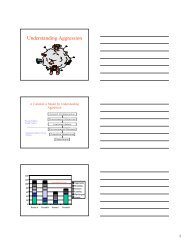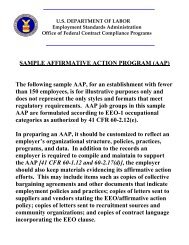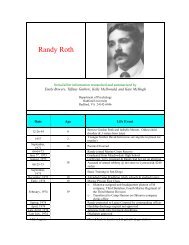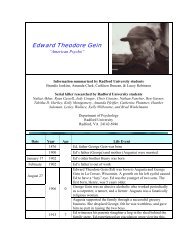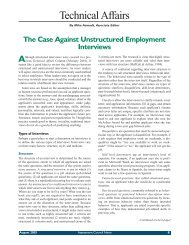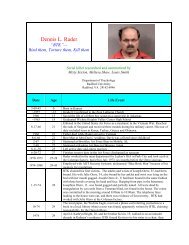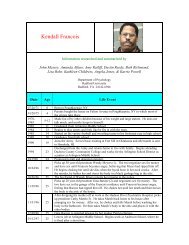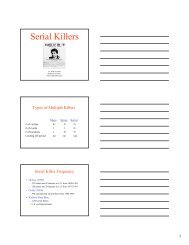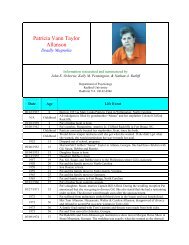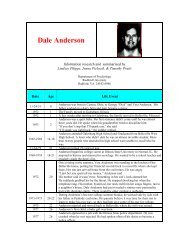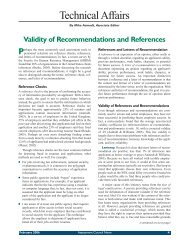Needs Assessment
Needs Assessment
Needs Assessment
Create successful ePaper yourself
Turn your PDF publications into a flip-book with our unique Google optimized e-Paper software.
Employee Training<br />
Difference Between Training and<br />
Organization Development<br />
• Training<br />
– Individual-based<br />
– Shorter-term focus<br />
• Organization Development<br />
– Organizational/group based<br />
– Longer-term focus<br />
The Role of Training<br />
Money Spent of Training<br />
• Organizations spend billions on training each year<br />
– $55.8 billion in 2006<br />
– $51.1 billion in 2005 (Dolezalek, 2005)<br />
– $51.4 billion in 2004 (Dolezalek, 2004)<br />
– $51.3 billion in 2003 (Galvin, 2003)<br />
• Training costs (ASTD, 2006)<br />
– 2.34% of payroll<br />
– $1,273 per employee (an increase from $955 in 2005)<br />
– 32 hours of training per employee per year (an increase from 26 in<br />
2004)<br />
• Need to consider<br />
– Direct costs<br />
– Indirect costs<br />
– Hidden costs<br />
1
The Role of Training<br />
Goals<br />
• Improve performance by increasing<br />
– Self-awareness<br />
– Knowledge<br />
– Skill<br />
– Motivation<br />
The Role of Training<br />
Global Types of Training<br />
• Basic skills<br />
• Technical skills<br />
• People skills<br />
• Personal effectiveness<br />
• Organizational maneuvering<br />
The Role of Training<br />
Roles<br />
• Selection<br />
• Skill enhancement<br />
• Performance management<br />
• Organization development<br />
• Human factors and ergonomics<br />
2
Training Steps<br />
• Determine training needs<br />
• Develop training program<br />
– Establish goals and objectives<br />
– Choose best training method<br />
– Prepare the training<br />
– Motivate employees<br />
– Conduct the training<br />
• Evaluate training success<br />
<strong>Needs</strong> <strong>Assessment</strong><br />
What is a Training Need?<br />
• Discrepancy between actual performance and<br />
– An ideal<br />
– A norm<br />
– A minimum<br />
– A desired state<br />
– An expected state<br />
3
Analysis of Need<br />
Four Key Questions<br />
• What are we trying to accomplish?<br />
• Why do we think there is a need for our training<br />
program?<br />
• Is there an actual need for our training<br />
program?<br />
• Is our idea for a training program practical?<br />
Analysis of Need<br />
What are We Trying to Accomplish?<br />
• Do we have a particular need in mind or are we<br />
trolling for unmet needs in general?<br />
• Is the dog wagging the tail or is the tail wagging<br />
the dog?<br />
• What is the real goal?<br />
– To help others?<br />
– To justify our job?<br />
Analysis of Need<br />
Why Do We Think There is a Need?<br />
• Normative Need (Expert opinion)<br />
• Felt Need (Client/employee opinion)<br />
• Expressed Need (requests for services)<br />
• Comparative Need<br />
– Surveys<br />
– Comparative data<br />
Source: Royce et al. (2006)<br />
4
Analysis of Need<br />
Is There an Actual Need for our<br />
Program?<br />
• Is there actually a problem or unmet need?<br />
• Are there existing programs trying to solve the<br />
problem?<br />
• Are there enough potential clients to justify a<br />
program?<br />
<strong>Needs</strong> Analysis<br />
• Organizational Analysis<br />
• Task Analysis<br />
• Person Analysis<br />
Organizational Analysis<br />
• Goals and objectives<br />
• Economic analysis<br />
• Organizational climate<br />
– Employee readiness<br />
• Attitudes<br />
• Time<br />
• Commitment<br />
– Management support<br />
• Resource analysis<br />
5
Analysis of Need<br />
Is the Program Practical?<br />
• Will people participate in the program?<br />
• Are the barriers insurmountable?<br />
• Do we have the expertise?<br />
• Do we have the funding?<br />
Resource Analysis<br />
• Funding<br />
–How much<br />
•Staff<br />
– Number<br />
– Skills<br />
– Availability<br />
• Physical resources<br />
– Office space<br />
– Phones<br />
– Computers<br />
– Vehicles<br />
Identifying Potential Stakeholders<br />
• Funding sources<br />
• Administrators<br />
• Staff<br />
• Community groups<br />
• Politicians<br />
• Businesses<br />
• Unions<br />
• Current, past, and future<br />
clients<br />
6
Task Analysis<br />
• Job analysis identifies<br />
–Tasks<br />
– Conditions under which tasks are performed<br />
– KSAOs needed to perform tasks under those conditions<br />
• Task analysis identifies how tasks are learned<br />
– Expected at time-of-hire<br />
– Easily taught on-the-job<br />
– Current training program<br />
– No training<br />
Task<br />
Example of a Task Analysis<br />
Answer customer questions about rates<br />
Process customer transactions<br />
Calm irate customers<br />
Check loan applications for accuracy<br />
Ask customers to complete VISA applications<br />
Input customer transactions into the computer<br />
Answer customer questions about services<br />
Person Analysis<br />
• Performance appraisal scores<br />
• Surveys<br />
• Interviews<br />
• Skill and knowledge tests<br />
• Critical incidents<br />
How task is learned<br />
Basic rate charts<br />
Basic teller training<br />
Loan processing course<br />
Basic teller training<br />
Basic teller training<br />
7
8<br />
Person Analysis Exercise<br />
2<br />
1<br />
5<br />
5<br />
3<br />
4<br />
5<br />
Hardwick<br />
2<br />
3<br />
1<br />
2<br />
1<br />
1<br />
4<br />
Gunn<br />
4<br />
3<br />
5<br />
3<br />
1<br />
5<br />
4<br />
Electra<br />
4<br />
2<br />
5<br />
5<br />
4<br />
5<br />
4<br />
Koplitz<br />
5<br />
5<br />
5<br />
5<br />
2<br />
2<br />
5<br />
Eubanks<br />
4<br />
1<br />
5<br />
5<br />
2<br />
4<br />
5<br />
Lange<br />
5<br />
4<br />
5<br />
4<br />
2<br />
5<br />
5<br />
Lodge<br />
3<br />
5<br />
5<br />
5<br />
4<br />
4<br />
5<br />
Woolery<br />
1<br />
4<br />
5<br />
5<br />
1<br />
5<br />
4<br />
Hogan<br />
5<br />
2<br />
5<br />
5<br />
3<br />
2<br />
5<br />
Walberg<br />
Names<br />
Services<br />
Knowledge<br />
Attendance<br />
Friendliness<br />
Cross-<br />
Selling<br />
Drawer<br />
Accuracy<br />
Data<br />
Input
Field Crew Member<br />
Riverbend Nursery<br />
Riner, Virginia<br />
Job Summary<br />
Field crew members are responsible for pulling plants that are to be delivered to<br />
customers. Crew members inspect the quality of the plants to be pulled, ensure the plants<br />
are properly tagged, unload plants at the loading dock, and replace plants that had been<br />
pulled with new plants.<br />
Work Activities<br />
Check Truck for Proper Functioning<br />
• Read oil and gas gage<br />
• Report low oil and gas to maintenance<br />
Gather Empty Flats<br />
• Read order to identify which flat sizes are needed (32, 15, or 6 plants per flat)<br />
• Stack flats in truck to fill throughout the day<br />
Pull Plants/Fill Flats<br />
• Identify location of plants in the nursery<br />
• Drive to location with truck and empty flats<br />
• Place gloves on hands if notified by safety sign on front of greenhouse<br />
• Fill flats as specified on the order<br />
• Check quality of plants (the health of top, bottom, and sides of the plants)<br />
• Notify head grower if crop of plants has quality problems<br />
Tag/Price Plants<br />
• Place proper tag on each plant<br />
• Place proper price on each plant<br />
Fill Truck/Unload Order<br />
• Place flats with pulled plants on truck bed<br />
• Secure flats with bungee cord<br />
• Drive plants to the dock<br />
• Unload flats at the dock<br />
• Refill truck with empty flats<br />
Double Check Order<br />
• Check to verify entire order has been pulled<br />
• Check for tag on each plant<br />
• Confirm proper quality of pulled order<br />
Replenish Plants<br />
• Pull younger plants from alternate greenhouse to emptied house<br />
• Refill plants that were pulled for order
Other Duties<br />
• Water plants when temperature is hot<br />
• Report tags that need be ordered to office<br />
Tools and Equipment Used<br />
• Truck<br />
• Tags<br />
• Bungee cords<br />
• Flats<br />
• Gloves (or other specified clothing for safety)<br />
Job Context<br />
The field crew member works on one of two shifts. The first shift works Monday<br />
through Thursday and the second shift works Tuesday, Wednesday, Friday, and Saturday.<br />
Both shifts start at 7:00 a.m. Both shifts work until at least 5:30 p.m., up to as late as<br />
9:00 p.m., depending on the season and month. Notification of specific closing time may<br />
not be known until halfway through the current workday. The months most common to<br />
working late hours include but are not limited to March through May, the peak season.<br />
Physical stress can be high in this position due to the time spent squatting,<br />
carrying heavy flats, and the amount of work that must be completed each day. In<br />
addition, a field crew member will spend most of the day in dirty surroundings. A field<br />
crew member must be prepared to work in all environmental conditions, including but not<br />
limited to extreme cold, extreme heat, rain, and snow. A field crew member will also<br />
need to withstand entering one extreme temperature to another when entering and exiting<br />
the greenhouses.<br />
Compensation and Compliance Information<br />
Evaluation and Performance<br />
The performance of the field crew member is reviewed by the team lead and the<br />
head grower.<br />
Competencies<br />
Upon Hire<br />
• Detail oriented<br />
• Ability to carry up to 30 pounds<br />
• Willingness to work in extreme weather conditions<br />
• Ability to bend, stoop, and squat<br />
After Hire<br />
• Knowledge of species of plants<br />
• Knowledge of the location of each plant<br />
• Familiarity with the nursery and its layout<br />
• Skill to recognize a poor quality plant<br />
• Can read or decipher order form in English



